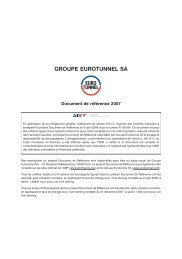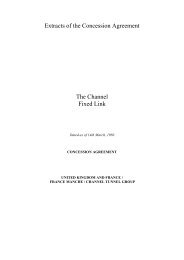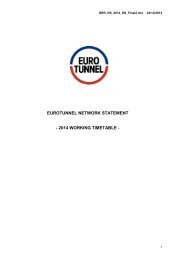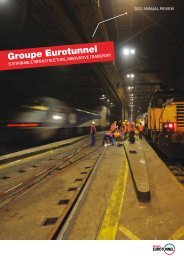- Page 1 and 2: GROUPE EUROTUNNEL SA4APR20070046162
- Page 3 and 4: SUMMARY6.4.4 Maintenance strategy 3
- Page 5 and 6: SUMMARY17.1 Human resources policy
- Page 7 and 8: SUMMARYANNEX I - TABLE OF SHAREHOLD
- Page 9 and 10: 1. PERSONS RESPONSIBLEValuation of
- Page 11 and 12: 3. SELECTED FINANCIAL INFORMATIONTh
- Page 13 and 14: 4. RISK FACTORSTHIS CHAPTER 4 SETS
- Page 15 and 16: 4. RISK FACTORSShares could have an
- Page 17: 4. RISK FACTORSRisks relating to Eu
- Page 21 and 22: 4. RISK FACTORSEurotunnel Group has
- Page 23 and 24: 5. INFORMATION ABOUT GET SA5.1 Hist
- Page 25 and 26: 5. INFORMATION ABOUT GET SAat nomin
- Page 27 and 28: 5. INFORMATION ABOUT GET SAIn the l
- Page 29 and 30: 6. DESCRIPTION OF EUROTUNNEL GROUP
- Page 31 and 32: 6. DESCRIPTION OF EUROTUNNEL GROUP
- Page 33 and 34: 6. DESCRIPTION OF EUROTUNNEL GROUP
- Page 35 and 36: 6. DESCRIPTION OF EUROTUNNEL GROUP
- Page 37 and 38: 6. DESCRIPTION OF EUROTUNNEL GROUP
- Page 39 and 40: 6. DESCRIPTION OF EUROTUNNEL GROUP
- Page 41 and 42: 6. DESCRIPTION OF EUROTUNNEL GROUP
- Page 43 and 44: 6. DESCRIPTION OF EUROTUNNEL GROUP
- Page 45 and 46: 6. DESCRIPTION OF EUROTUNNEL GROUP
- Page 47 and 48: 6. DESCRIPTION OF EUROTUNNEL GROUP
- Page 49 and 50: 7. ORGANISATIONAL STRUCTURESimplifi
- Page 51 and 52: 8. PROPERTY, PLANT AND EQUIPMENT8.1
- Page 53 and 54: 9. OPERATING AND FINANCIAL REVIEWb)
- Page 55 and 56: 9. OPERATING AND FINANCIAL REVIEWPa
- Page 57 and 58: 9. OPERATING AND FINANCIAL REVIEW9.
- Page 59 and 60: 9. OPERATING AND FINANCIAL REVIEWTh
- Page 61 and 62: 10. CASH FLOW AND SHARE CAPITAL10.1
- Page 63 and 64: 10. CASH FLOW AND SHARE CAPITALc) C
- Page 65 and 66: 12. INFORMATION ON BUSINESS TRENDS1
- Page 67 and 68: 12. INFORMATION ON BUSINESS TRENDSR
- Page 69 and 70:
14. BOARD OF DIRECTORS, MANAGEMENT
- Page 71 and 72:
14. BOARD OF DIRECTORS, MANAGEMENT
- Page 73 and 74:
14. BOARD OF DIRECTORS, MANAGEMENT
- Page 75 and 76:
14. BOARD OF DIRECTORS, MANAGEMENT
- Page 77 and 78:
14. BOARD OF DIRECTORS, MANAGEMENT
- Page 79 and 80:
15. REMUNERATION AND BENEFITS15.1 R
- Page 81 and 82:
15. REMUNERATION AND BENEFITSboards
- Page 83 and 84:
16. BOARD AND MANAGEMENT PRACTICESo
- Page 85 and 86:
16. BOARD AND MANAGEMENT PRACTICESa
- Page 87 and 88:
16. BOARD AND MANAGEMENT PRACTICESB
- Page 89 and 90:
16. BOARD AND MANAGEMENT PRACTICESA
- Page 91 and 92:
16. BOARD AND MANAGEMENT PRACTICESD
- Page 93 and 94:
16. BOARD AND MANAGEMENT PRACTICESP
- Page 95 and 96:
16. BOARD AND MANAGEMENT PRACTICES1
- Page 97 and 98:
17. EMPLOYEESThe average total cont
- Page 99 and 100:
17. EMPLOYEESoffering all employees
- Page 101 and 102:
17. EMPLOYEES17.5 Employee sharehol
- Page 103 and 104:
19. RELATED PARTY TRANSACTIONSThere
- Page 105 and 106:
20. FINANCIAL INFORMATION CONCERNIN
- Page 107 and 108:
20. FINANCIAL INFORMATION CONCERNIN
- Page 109 and 110:
20. FINANCIAL INFORMATION CONCERNIN
- Page 111 and 112:
20. FINANCIAL INFORMATION CONCERNIN
- Page 113 and 114:
21. ADDITIONAL INFORMATIONpossible
- Page 115 and 116:
21. ADDITIONAL INFORMATIONThe share
- Page 117 and 118:
21. ADDITIONAL INFORMATIONA GET SA
- Page 119 and 120:
21. ADDITIONAL INFORMATIONmeeting,
- Page 121 and 122:
21. ADDITIONAL INFORMATION21.2.10 M
- Page 123 and 124:
22. MATERIAL CONTRACTSto comply wit
- Page 125 and 126:
22. MATERIAL CONTRACTSWith respect
- Page 127 and 128:
22. MATERIAL CONTRACTSin interest f
- Page 129 and 130:
22. MATERIAL CONTRACTSrelating to t
- Page 131 and 132:
23. DOCUMENTS AVAILABLE TO THE PUBL
- Page 133 and 134:
23. DOCUMENTS AVAILABLE TO THE PUBL
- Page 135 and 136:
23. DOCUMENTS AVAILABLE TO THE PUBL
- Page 137 and 138:
25. DEFINITIONSAdditional Ordinary
- Page 139 and 140:
25. DEFINITIONSGovernmental EntityH
- Page 141 and 142:
25. DEFINITIONSSDES ReturnSDES Secu
- Page 143 and 144:
ANNEX I TABLE OF SHAREHOLDINGS AS A
- Page 145 and 146:
ANNEX I - TABLE OF SHAREHOLDINGS AS
- Page 147 and 148:
ANNEX II - SPECIAL REPORT OF THE CO
- Page 149 and 150:
ANNEX IIICOMBINED ACCOUNTS OF TNU (
- Page 151 and 152:
ANNEX III - COMBINED ACCOUNTS OF TN
- Page 153 and 154:
ANNEX III - COMBINED ACCOUNTS OF TN
- Page 155 and 156:
ANNEX III - COMBINED ACCOUNTS OF TN
- Page 157 and 158:
ANNEX III - COMBINED ACCOUNTS OF TN
- Page 159 and 160:
ANNEX III - COMBINED ACCOUNTS OF TN
- Page 161 and 162:
ANNEX III - COMBINED ACCOUNTS OF TN
- Page 163 and 164:
ANNEX III - COMBINED ACCOUNTS OF TN
- Page 165 and 166:
ANNEX III - COMBINED ACCOUNTS OF TN
- Page 167 and 168:
ANNEX III - COMBINED ACCOUNTS OF TN
- Page 169 and 170:
ANNEX III - COMBINED ACCOUNTS OF TN
- Page 171 and 172:
ANNEX III - COMBINED ACCOUNTS OF TN
- Page 173 and 174:
ANNEX III - COMBINED ACCOUNTS OF TN
- Page 175 and 176:
ANNEX III - COMBINED ACCOUNTS OF TN
- Page 177 and 178:
ANNEX III - COMBINED ACCOUNTS OF TN
- Page 179 and 180:
ANNEX III - COMBINED ACCOUNTS OF TN
- Page 181 and 182:
ANNEX III - COMBINED ACCOUNTS OF TN
- Page 183 and 184:
ANNEX III - COMBINED ACCOUNTS OF TN
- Page 185 and 186:
ANNEX III - COMBINED ACCOUNTS OF TN
- Page 187 and 188:
ANNEX III - COMBINED ACCOUNTS OF TN
- Page 189 and 190:
ANNEX III - COMBINED ACCOUNTS OF TN
- Page 191 and 192:
ANNEX III - COMBINED ACCOUNTS OF TN
- Page 193 and 194:
ANNEX III - COMBINED ACCOUNTS OF TN
- Page 195 and 196:
ANNEX III - COMBINED ACCOUNTS OF TN
- Page 197 and 198:
ANNEX III - COMBINED ACCOUNTS OF TN
- Page 199 and 200:
ANNEX III - COMBINED ACCOUNTS OF TN
- Page 201 and 202:
ANNEX III - COMBINED ACCOUNTS OF TN
- Page 203 and 204:
ANNEX III - COMBINED ACCOUNTS OF TN
- Page 205 and 206:
ANNEX III - COMBINED ACCOUNTS OF TN
- Page 207 and 208:
ANNEX III - COMBINED ACCOUNTS OF TN
- Page 209 and 210:
ANNEX III - COMBINED ACCOUNTS OF TN
- Page 211 and 212:
ANNEX III - COMBINED ACCOUNTS OF TN
- Page 213 and 214:
ANNEX III - COMBINED ACCOUNTS OF TN
- Page 215 and 216:
ANNEX III - COMBINED ACCOUNTS OF TN
- Page 217 and 218:
ANNEX IV - CONSOLIDATED ACCOUNTS OF
- Page 219 and 220:
ANNEX IV - CONSOLIDATED ACCOUNTS OF
- Page 221 and 222:
ANNEX IV - CONSOLIDATED ACCOUNTS OF
- Page 223 and 224:
ANNEX IV - CONSOLIDATED ACCOUNTS OF
- Page 225 and 226:
ANNEX IV - CONSOLIDATED ACCOUNTS OF
- Page 227 and 228:
ANNEX IV - CONSOLIDATED ACCOUNTS OF
- Page 229 and 230:
ANNEX IV - CONSOLIDATED ACCOUNTS OF
- Page 231 and 232:
ANNEX IV - CONSOLIDATED ACCOUNTS OF
- Page 233 and 234:
ANNEX IV - CONSOLIDATED ACCOUNTS OF
- Page 235 and 236:
ANNEX IV - CONSOLIDATED ACCOUNTS OF
- Page 237 and 238:
ANNEX IV - CONSOLIDATED ACCOUNTS OF
- Page 239 and 240:
ANNEX IV - CONSOLIDATED ACCOUNTS OF
- Page 241 and 242:
ANNEX IV - CONSOLIDATED ACCOUNTS OF
- Page 243 and 244:
ANNEX IV - CONSOLIDATED ACCOUNTS OF
- Page 245 and 246:
ANNEX IV - CONSOLIDATED ACCOUNTS OF
- Page 247 and 248:
ANNEX IV - CONSOLIDATED ACCOUNTS OF
- Page 249 and 250:
ANNEX IV - CONSOLIDATED ACCOUNTS OF
- Page 251 and 252:
ANNEX IV - CONSOLIDATED ACCOUNTS OF
- Page 253 and 254:
ANNEX IV - CONSOLIDATED ACCOUNTS OF
- Page 255 and 256:
ANNEX IV - CONSOLIDATED ACCOUNTS OF
- Page 257 and 258:
ANNEX VREPORTS OF THE STATUTORY AUD
- Page 259 and 260:
ANNEX VIREPORTS OF THE STATUTORY AU
- Page 261 and 262:
ANNEX VIIREPORT OF THE COMMISSAIRES
- Page 263 and 264:
ANNEX VIIIDESCRIPTION OF THE INTERN
- Page 265 and 266:
ANNEX VIII - DESCRIPTION OF THE INT
- Page 267 and 268:
ANNEX VIII - DESCRIPTION OF THE INT
- Page 269 and 270:
ANNEX VIII - DESCRIPTION OF THE INT
- Page 271 and 272:
ANNEX VIII - DESCRIPTION OF THE INT
- Page 273 and 274:
ANNEX XGROUPE EUROTUNNEL SA COMPANY
- Page 275 and 276:
ANNEX X - GROUPE EUROTUNNEL SA COMP
- Page 277 and 278:
ANNEX X - GROUPE EUROTUNNEL SA COMP
- Page 279 and 280:
ANNEX X - GROUPE EUROTUNNEL SA COMP
- Page 281 and 282:
ANNEX X - GROUPE EUROTUNNEL SA COMP
- Page 283 and 284:
ANNEX X - GROUPE EUROTUNNEL SA COMP
- Page 285 and 286:
ANNEX XI - GENERAL REPORT OF THE CO
- Page 287 and 288:
ANNEX XII - GET SA TRAVEL PRIVILEGE
- Page 289 and 290:
ANNEX XIIIREFERENCE DOCUMENT CHECKL
- Page 291 and 292:
ANNEX XIII - REFERENCE DOCUMENT CHE
- Page 293 and 294:
ANNEX XIII - REFERENCE DOCUMENT CHE
- Page 295 and 296:
ANNEX XIVTABLE OF CROSS-REFERENCEST
- Page 297 and 298:
ANNEX XIV - TABLE OF CROSS-REFERENC
- Page 299 and 300:
ANNEX XIV - TABLE OF CROSS-REFERENC







